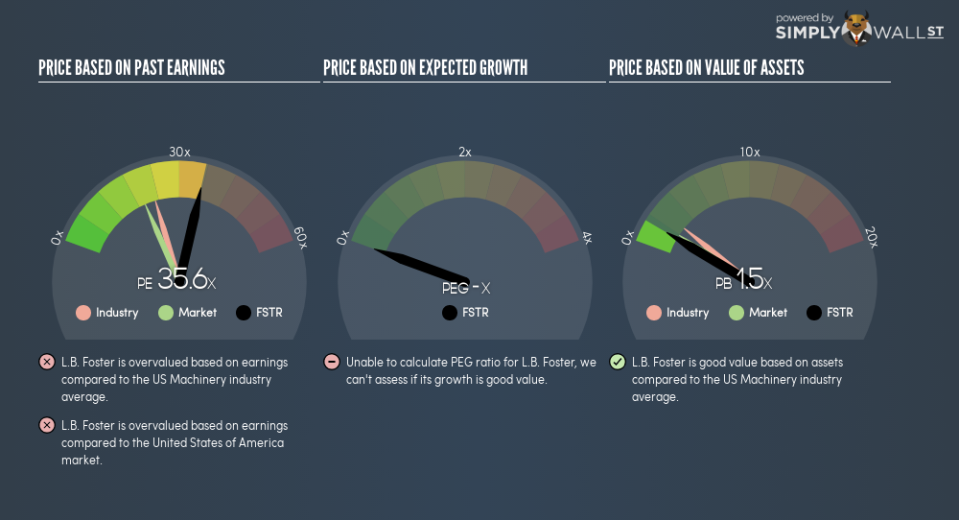Does LB Foster Company’s (NASDAQ:FSTR) PE Ratio Warrant A Sell?

This article is intended for those of you who are at the beginning of your investing journey and want to start learning about core concepts of fundamental analysis on practical examples from today’s market.
LB Foster Company (NASDAQ:FSTR) is currently trading at a trailing P/E of 35.6, which is higher than the industry average of 23. Though this might seem to be a negative, you might change your mind after I explain the assumptions behind the P/E ratio. In this article, I will deconstruct the P/E ratio and highlight what you need to be careful of when using the P/E ratio.
View our latest analysis for L.B. Foster
Demystifying the P/E ratio
The P/E ratio is a popular ratio used in relative valuation since earnings power is a key driver of investment value. It compares a stock’s price per share to the stock’s earnings per share. A more intuitive way of understanding the P/E ratio is to think of it as how much investors are paying for each dollar of the company’s earnings.
P/E Calculation for FSTR
Price-Earnings Ratio = Price per share ÷ Earnings per share
FSTR Price-Earnings Ratio = $22.1 ÷ $0.621 = 35.6x
On its own, the P/E ratio doesn’t tell you much; however, it becomes extremely useful when you compare it with other similar companies. We want to compare the stock’s P/E ratio to the average of companies that have similar characteristics as FSTR, such as size and country of operation. A quick method of creating a peer group is to use companies in the same industry, which is what I will do. At 35.6, FSTR’s P/E is higher than its industry peers (23). This implies that investors are overvaluing each dollar of FSTR’s earnings. This multiple is a median of profitable companies of 25 Machinery companies in US including EnPro Industries, Hebron Technology and China Yuchai International. You could think of it like this: the market is pricing FSTR as if it is a stronger company than the average of its industry group.
A few caveats
However, it is important to note that our examination of the stock is based on certain assumptions. The first is that our “similar companies” are actually similar to FSTR. If not, the difference in P/E might be a result of other factors. For example, if LB Foster Company is growing faster than its peers, then it would deserve a higher P/E ratio. We should also be aware that the stocks we are comparing to FSTR may not be fairly valued. So while we can reasonably surmise that it is optimistically valued relative to a peer group, it might be fairly valued, if the peer group is undervalued.
What this means for you:
You may have already conducted fundamental analysis on the stock as a shareholder, so its current overvaluation could signal a potential selling opportunity to reduce your exposure to FSTR. Now that you understand the ins and outs of the PE metric, you should know to bear in mind its limitations before you make an investment decision. Remember that basing your investment decision off one metric alone is certainly not sufficient. There are many things I have not taken into account in this article and the PE ratio is very one-dimensional. If you have not done so already, I urge you to complete your research by taking a look at the following:
Financial Health: Are FSTR’s operations financially sustainable? Balance sheets can be hard to analyze, which is why we’ve done it for you. Check out our financial health checks here.
Past Track Record: Has FSTR been consistently performing well irrespective of the ups and downs in the market? Go into more detail in the past performance analysis and take a look at the free visual representations of FSTR’s historicals for more clarity.
Other High-Performing Stocks: Are there other stocks that provide better prospects with proven track records? Explore our free list of these great stocks here.
To help readers see past the short term volatility of the financial market, we aim to bring you a long-term focused research analysis purely driven by fundamental data. Note that our analysis does not factor in the latest price-sensitive company announcements.
The author is an independent contributor and at the time of publication had no position in the stocks mentioned. For errors that warrant correction please contact the editor at editorial-team@simplywallst.com.

 Yahoo Finance
Yahoo Finance 
